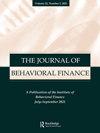一次性囚徒困境中的合作动机
IF 1.7
3区 经济学
Q3 BUSINESS, FINANCE
引用次数: 0
摘要
摘要本文研究了单次囚徒困境(one-shot Prisoner’s Dilemma)下的合作动机。已有研究发现,单次PD博弈中的合作率可以通过合作产生的社会剩余进行经验排序。该研究采用了同步PD游戏中合作的对称收益。因此,在这种情况下,辨别合作动机是不可能的,因为三个突出的社会福利标准,社会剩余(效率)偏好,罗尔斯最大偏好和不平等厌恶做出了相同的预测。在本文中,我们进行了一个实验,以确定这些社会偏好中哪一个最能解释合作率的差异,并研究不合作风险的影响。本文章由计算机程序翻译,如有差异,请以英文原文为准。
Motives for Cooperation in the One-Shot Prisoner’s Dilemma
Abstract We investigate the motives for cooperation in the one-shot Prisoner’s Dilemma (PD). A prior study finds that cooperation rates in one-shot PD games can be ranked empirically by the social surplus from cooperation. That study employs symmetric payoffs from cooperation in simultaneous PD games. Hence, in that setting, it is not possible to discern the motives for cooperation since three prominent social welfare criteria, social surplus (efficiency) preferences, Rawlsian maximin preferences, and inequity aversion make the same predictions. In the present paper, we conduct an experiment to identify which of these social preferences best explains differences in cooperation rates and to study the effects of the risk of non-cooperation.
求助全文
通过发布文献求助,成功后即可免费获取论文全文。
去求助
来源期刊

Journal of Behavioral Finance
Multiple-
CiteScore
4.60
自引率
10.50%
发文量
34
期刊介绍:
In Journal of Behavioral Finance , leaders in many fields are brought together to address the implications of current work on individual and group emotion, cognition, and action for the behavior of investment markets. They include specialists in personality, social, and clinical psychology; psychiatry; organizational behavior; accounting; marketing; sociology; anthropology; behavioral economics; finance; and the multidisciplinary study of judgment and decision making. The journal will foster debate among groups who have keen insights into the behavioral patterns of markets but have not historically published in the more traditional financial and economic journals. Further, it will stimulate new interdisciplinary research and theory that will build a body of knowledge about the psychological influences on investment market fluctuations. The most obvious benefit will be a new understanding of investment markets that can greatly improve investment decision making. Another benefit will be the opportunity for behavioral scientists to expand the scope of their studies via the use of the enormous databases that document behavior in investment markets.
 求助内容:
求助内容: 应助结果提醒方式:
应助结果提醒方式:


